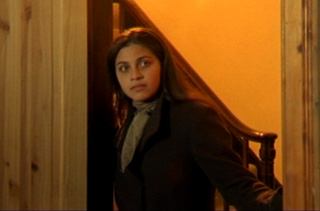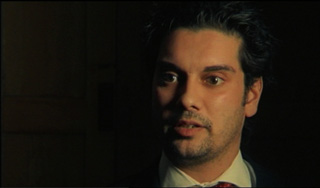Just recently I finally managed to see Antonioni's Red Desert.
As I have been busy getting ready for the workshop in December I have been thinking of the idea of what has been called temp mort, which is seen in Red Desert and The Passenger.
The dead time is that moment when the characters have exited the scene and the camera lingers for too long on the empty space. In the conventional world of British cinema this would be considered bad form or sloppy editing, but here it suggests that this space is autonomous. It has its own reality and the story we are following just happened to occupy the space for a time.
(You can read much more about this idea in Seymour Chatman's excellent book on the director, Antonioni or, the Surface of the World)
A variation of this idea occurs in a number of Antonioni's film. In The Passenger, when Locke goes out into the desert to make contact with the rebels he sees a man coming towards him on a camel. He assumes that this man is his contact and as the man passes him the camera pans to follow the man. But it is a dead end. The man is not his contact and plays no part this story, though we assume that he has a story of his own.
For me the attraction is important for the first part of the three-part story, in which Sophie becomes aware of another reality, by the leaking of one into another. But in the story we only see two, whereas I want to suggest an awareness of all these possibilities, which I suppose is some moment of awareness of the infiniteness of the universe.
So temp mort would be used to suggest those moments when we become aware not just of one other possibilities, but an infinite number.
Sunday, November 26, 2006
Tuesday, November 21, 2006
Photos from the film shoot
Wednesday, November 15, 2006
The new synopsis - 3 part version
Sophie (+ Paul)
For Sophie and Paul, it is over. They have had an ideal relationship and Paul struggles to understand how it went wrong. But for Sophie, that she is with Paul is down to chance. This means that good or bad could easily be reversed. All that stands in the way of these other possibilities is fear.
Claire, her friend, cannot understand how Sophie could throw Paul and a great relationship away. She is resentful, and reminds Sophie that it could've been her, Claire, that was with Paul. She could've been happy.
Paul recognises the danger to themselves - 'We are not an accident' - but it is too late. Sophie finds a way to overcome her fear and discovers another possible life.
Claire (-Paul)
In this story Claire has what she wanted. Paul. But they argue, Paul frustrated that Claire really is not committed or passionate about them together. Can Claire really change?
She sees her chance when her sister drops by unexpectedly. She is going away to get away from Nick, her boyfriend. He is too much. Can Claire look after her flat?
In Natalie's flat Claire finds photos of Nick. He has an intensity that is missing from her relationship with Paul. She decides to take a chance. She leaves Paul - just disappears and moves into Natalie's flat. And then she goes picking up the threads of Natalie's life, her friends, and work colleagues, and Nick. Her pretext is apologising for Natalie's bad behaviour, but her motive is to become someone else.
But can Claire finally change?
Paul (-Claire)
With Sophie, Paul knew who he was and what he wanted, but with Claire he is another man. For Paul, Claire's reticence and secrecy are part of her inability to commit to their relationship, driving Paul to despair. For Paul, his relationships are fundamental to who he is as a person. Perhaps out of peevishness, or just confusion he spends the night with a stranger, and returns in the morning, wondering about the consequences. But Claire has disappeared. He begins to search for her and his first visit is Sophie. Looking beyond her hostility he is struck by the unfairness of chance: he could've been with Sophie, he could've been someone else. Feeling the weight of this injustice, his life goes into a spiral. Paul indeed becomes someone else. He is unrecognisable.
For Sophie and Paul, it is over. They have had an ideal relationship and Paul struggles to understand how it went wrong. But for Sophie, that she is with Paul is down to chance. This means that good or bad could easily be reversed. All that stands in the way of these other possibilities is fear.
Claire, her friend, cannot understand how Sophie could throw Paul and a great relationship away. She is resentful, and reminds Sophie that it could've been her, Claire, that was with Paul. She could've been happy.
Paul recognises the danger to themselves - 'We are not an accident' - but it is too late. Sophie finds a way to overcome her fear and discovers another possible life.
Claire (-Paul)
In this story Claire has what she wanted. Paul. But they argue, Paul frustrated that Claire really is not committed or passionate about them together. Can Claire really change?
She sees her chance when her sister drops by unexpectedly. She is going away to get away from Nick, her boyfriend. He is too much. Can Claire look after her flat?
In Natalie's flat Claire finds photos of Nick. He has an intensity that is missing from her relationship with Paul. She decides to take a chance. She leaves Paul - just disappears and moves into Natalie's flat. And then she goes picking up the threads of Natalie's life, her friends, and work colleagues, and Nick. Her pretext is apologising for Natalie's bad behaviour, but her motive is to become someone else.
But can Claire finally change?
Paul (-Claire)
With Sophie, Paul knew who he was and what he wanted, but with Claire he is another man. For Paul, Claire's reticence and secrecy are part of her inability to commit to their relationship, driving Paul to despair. For Paul, his relationships are fundamental to who he is as a person. Perhaps out of peevishness, or just confusion he spends the night with a stranger, and returns in the morning, wondering about the consequences. But Claire has disappeared. He begins to search for her and his first visit is Sophie. Looking beyond her hostility he is struck by the unfairness of chance: he could've been with Sophie, he could've been someone else. Feeling the weight of this injustice, his life goes into a spiral. Paul indeed becomes someone else. He is unrecognisable.
Tuesday, November 07, 2006
Film class excercise
I have also been busy with 16mm film class, which sets out to introduce the students to the basics of a film shoot.
Last weekend was the shooting weekend and I took the opportunity to experiment with the shooting style.
I chose a scene from the revised outline when Sophie returns from her night excursion. The night before, in the middle of a discussion with Paul about how they met, Sophie disappears. She goes out into the night, and discover a parallel world (London at night). It is really about her overcoming fear and reaffirming her belief in chance.
Now that it is morning she returns to Paul. She wants to explain, but Paul is too angry to listen to her.While Paul understood that their marriage is over, he did not expect it to end this way. It is almost that she had an affair over the course of the night. She has betrayed their intimacy.
I had intended this scene to happen in Paul's office, but we had to take what was given to us, which was a Victorian house.
Paul enters the room and we decided (we being Todd, acting as my DOP) he would sit down. He is distraught but his way to deal with it is to pretend to be in control. He of course betrays himself several times in speech. The camera would look down on him, so that we could express his lack of status.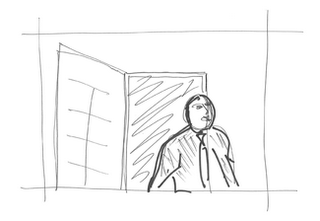
Sopie follows him, but though she has been here innumerable times before this morning she doesn't feel welcome. She hovers in the doorway, in the centre of frame, at a distance. We don't come any closer, as if we could not know what is happening with her any more than Paul. She is in the centre of the frame as if she didn't need anyone. And the camera looks up to her. Her status is higher than Pauls.
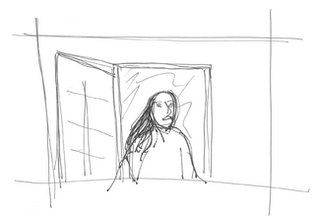
Our reverse is a close-up of Paul - we do know what is happening with Paul as he does most of the talking - and he is frame-right, with a void frame-left. As if he were expecting Sophie to fill that empty space.
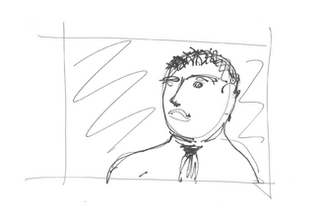
At least that was the plan. But as we were rushed (when aren't you rushed on a film set?) we made mistakes. We shot Sophie first, and had Paul feed her his lines off-camera. But we forgot to have him sit down, so her eye-line was level to him, instead of looking down to him if were seated. To match the reverse we had to Paul standing as well. We missed out being able to use camera angle to express status in the scene.
The film is currently in the lab. Next week we will be editing, and I will post some images.
Thank you to my friends Ant and Mansi for coming out on a Saturday afternoon to act for me. And Todd Pacey my DOP, and everyone else in the class.
Last weekend was the shooting weekend and I took the opportunity to experiment with the shooting style.
I chose a scene from the revised outline when Sophie returns from her night excursion. The night before, in the middle of a discussion with Paul about how they met, Sophie disappears. She goes out into the night, and discover a parallel world (London at night). It is really about her overcoming fear and reaffirming her belief in chance.
Now that it is morning she returns to Paul. She wants to explain, but Paul is too angry to listen to her.While Paul understood that their marriage is over, he did not expect it to end this way. It is almost that she had an affair over the course of the night. She has betrayed their intimacy.
I had intended this scene to happen in Paul's office, but we had to take what was given to us, which was a Victorian house.
Paul enters the room and we decided (we being Todd, acting as my DOP) he would sit down. He is distraught but his way to deal with it is to pretend to be in control. He of course betrays himself several times in speech. The camera would look down on him, so that we could express his lack of status.

Sopie follows him, but though she has been here innumerable times before this morning she doesn't feel welcome. She hovers in the doorway, in the centre of frame, at a distance. We don't come any closer, as if we could not know what is happening with her any more than Paul. She is in the centre of the frame as if she didn't need anyone. And the camera looks up to her. Her status is higher than Pauls.

Our reverse is a close-up of Paul - we do know what is happening with Paul as he does most of the talking - and he is frame-right, with a void frame-left. As if he were expecting Sophie to fill that empty space.

At least that was the plan. But as we were rushed (when aren't you rushed on a film set?) we made mistakes. We shot Sophie first, and had Paul feed her his lines off-camera. But we forgot to have him sit down, so her eye-line was level to him, instead of looking down to him if were seated. To match the reverse we had to Paul standing as well. We missed out being able to use camera angle to express status in the scene.
The film is currently in the lab. Next week we will be editing, and I will post some images.
Thank you to my friends Ant and Mansi for coming out on a Saturday afternoon to act for me. And Todd Pacey my DOP, and everyone else in the class.
Where have I been?
Whew!
It has been a long time, but it has been necessary.
I have completely revised the treatment/outline and I am now planning a workshop with actors for the end of November/early-December.
What has changed?
I think more has changed than stayed the same, but essentially it is simpler and clearer than it was before. I was especially conscious of removing the tricks from the script, which only served to get in the way. For example, in Part 2 Claire had a twin sister, who disappears. Claire, seeing that her sister is somehow able to be the passionate, committed person she wants to be, decides to take on her life and pretend to be her. Yes, I know.
In the revised version she still takes on her sister's life, but they are not twins and it is not a case of stolen identity.
It has been a long time, but it has been necessary.
I have completely revised the treatment/outline and I am now planning a workshop with actors for the end of November/early-December.
What has changed?
I think more has changed than stayed the same, but essentially it is simpler and clearer than it was before. I was especially conscious of removing the tricks from the script, which only served to get in the way. For example, in Part 2 Claire had a twin sister, who disappears. Claire, seeing that her sister is somehow able to be the passionate, committed person she wants to be, decides to take on her life and pretend to be her. Yes, I know.
In the revised version she still takes on her sister's life, but they are not twins and it is not a case of stolen identity.
Subscribe to:
Posts (Atom)
